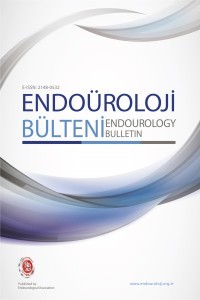Genç Yaşta Görülen Transizyonel Hücreli Mesane Karsinomunda Genetik Yatkınlık Var Mıdır?
Mesane Kanseri, gen değişimleri, transizyonel hücreli karsinom, genç hasta
Is There A Genetic Predisposition for Transitional Cell Carcinoma of the Bladder at a Young Age?
___
- 1. Bray F, Ferlay J, Soerjomataram I, Siegel RL, Torre LA, Jemal A (2018) Global cancer statistics 2018: GLOBOCAN estimates of incidence and mortality worldwide for 36 cancers in 185 countries. CA Cancer J Clin. 2018;68:394-424. https://doi.org/10.3322/caac.21492
- 2. Ferlay J, Colombet M, Soerjomataram I, Mathers C, Parkin DM, Pineros M, Znaor A, Bray F (2019) Estimating the global cancer incidence and mortality in 2018: GLOBOCAN sources and methods. Int J Cancer. 2019;144:1941-1953. https://doi.org/10.1002/ijc.31937
- 3. Freedman ND, Silverman DT, Hollenbeck AR, Schatzkin A, Abnet CC (2011) Association between smoking and risk of bladder cancer among men and women. JAMA. 2011;306:737-745. https://doi.org/10.1001/jama.2011.1142
- 4. Sun JW, Zhao LG, Yang Y, Ma X, Wang YY, Xiang YB (2015) Obesity and risk of bladder cancer: a dose-response meta-analysis of 15 cohort studies. PLoS One. 2015;10:e0119313. https://doi.org/10.1371/journal.pone.0119313
- 5. Gu J, Wu X (2011) Genetic susceptibility to bladder cancer risk and outcome. Per Med. 2011;8:365-374. https://doi.org/10.2217/pme.11.15
- 6. Cordon-Cardo C (2008) Molecular alterations associated with bladder cancer initiation and progression. Scand J Urol Nephrol Suppl:2008;154-165. https://doi.org/10.1080/03008880802291915
- 7. Kutarski PW, Padwell A (1993) Transitional cell carcinoma of the bladder in young adults. Br J Urol. 1993;72:749-755. https://doi.org/10.1111/j.1464-410x.1993.tb16261.x
- 8. Johnson DE, Hillis S (1978) Carcinoma of the bladder in patients less than 40 years old. J Urol. 1978;120:172-173. https://doi.org/10.1016/s0022-5347(17)57090-1
- 9. Wild PJ, Giedl J, Stoehr R, Junker K, Boehm S, van Oers JM, Zwarthoff EC, Blaszyk H, Fine SW, Humphrey PA, Dehner LP, Amin MB, Epstein JI, Hartmann A (2007) Genomic aberrations are rare in urothelial neoplasms of patients 19 years or younger. J Pathol. 2007;211:18-25. https://doi.org/10.1002/path.2075
- 10. Owen HC, Giedl J, Wild PJ, Fine SW, Humphrey PA, Dehner LP, Amin MB, Epstein JI, Blaszyk H, Hughes D, Hartmann A, Stoehr R, Catto JW (2010) Low frequency of epigenetic events in urothelial tumors in young patients. J Urol.2010;184:459-463. https://doi.org/10.1016/j.juro.2010.03.131
- 11. Lopez-Beltran A, Montironi R (2004) Non-invasive urothelial neoplasms: according to the most recent WHO classification. Eur Urol. 2004;46:170-176. https://doi.org/10.1016/j.eururo.2004.03.017
- 12. Wan J, Grossman HB (1989) Bladder carcinoma in patients age 40 years or younger. C cancer. 1989;64:178-181. https://doi.org/10.1002/1097-0142(19890701)64:1<178::aid-cncr2820640130>3.0.co;2-b
- 13. Riegert-Johnson DL, Gleeson FC, Roberts M, Tholen K, Youngborg L, Bullock M, Boardman LA (2010) Cancer and Lhermitte-Duclos disease are common in Cowden syndrome patients. Hered Cancer Clin Pract. 2010;8:6. https://doi.org/10.1186/1897-4287-8-6
- 14 Van der Post RS, Kiemeney LA, Ligtenberg MJ, Witjes JA, Hulsbergen-van de Kaa CA, Bodmer D, Schaap L, Kets CM, van Krieken JH, Hoogerbrugge N (2010) Risk of urothelial bladder cancer in Lynch syndrome is increased, in particular among MSH2 mutation carriers. J Med Genet. 2010;47:464-470. https://doi.org/10.1136/jmg.2010.076992
- 15. Benson RC, Jr., Tomera KM, Kelalis PP (1983) Transitional cell carcinoma of the bladder in children and adolescents. J Urol. 1983;130:54-55. https://doi.org/10.1016/s0022-5347(17)50950-7
- 16. Chang SY, Ma CP (1987) Transitional cell carcinoma of the urinary bladder in patients under 40 years of age. Br J Urol. 1987;60:343-344. https://doi.org/10.1111/j.1464-410x.1987.tb04981.x
- 17. Habuchi T, Takahashi T, Kakinuma H, Wang L, Tsuchiya N, Satoh S, Akao T, Sato K, Ogawa O, Knowles MA (2001) Hypermethylation at 9q32-33 tumour suppressor region is age-related in normal urothelium and an early and frequent alteration in bladder cancer. Oncogene. 2001;20:531-537 . https://doi.org/10.1038/sj.onc.1204122
- 18. Linn JF, Sesterhenn I, Mostofi FK, Schoenberg M (1998) The molecular characteristics of bladder cancer in young patients. J Urol. 1998;159:1493-1496. https://doi.org/10.1097/00005392-199805000-00022
- 19. Fine SW, Humphrey PA, Dehner LP, Amin MB, Epstein JI (2005) Urothelial neoplasms in patients 20 years or younger: a clinicopathological analysis using the world health organization 2004 bladder consensus classification. The Journal of urology. 2005;174:1976-1980. https://doi.org/10.1097/01.ju.0000176801.16827.82
- 20. Yossepowitch O, Dalbagni G (2002) Transitional cell carcinoma of the bladder in young adults: presentation, natural history and outcome. J Urol. 2002;168:61-66. https://doi.org/10.1016/S0022-5347(05)64832-X
- 21. Dason S, Wong NC (2021) Environmental and Genetic Factors Contributing to Bladder Carcinogenesis. Comprehensive Diagnostic Approach to Bladder Cancer. Springer, pp 2021;13-44. https://doi.org/10.1007/978-3-030-82048-0_2
- Yayın Aralığı: 3
- Başlangıç: 2020
- Yayıncı: Pera Yayıncılık
Genç Yaşta Görülen Transizyonel Hücreli Mesane Karsinomunda Genetik Yatkınlık Var Mıdır?
Selim TAŞ, Ali Erhan EREN, Mahmut Taha ÖLÇÜCÜ, Barış PAKSOY, Ekrem İSLAMOĞLU, Mehmet Salih BOĞA
Kompleks Üst Üriner Sistem Taş Tedavisinde Robotik Cerrahinin Rolü: Tek Merkez Deneyimi
Murat Can KİREMİT, Yakup KORDAN
Burhan COŞKUN, Halit Mustafa ACAR, Ahmet Eren TOTO, Gökhan OCAKOĞLU, Omer Faruk ASLAN, Onur KAYGİSİZ
Robot Yardımlı Böbrek Naklinde Bifazlı Sıvı Tedavisi’nin Etkinliği
Burhan COŞKUN, Sezin TÜRK KAYA, Yavuz Mert AYDIN, İsmail İFŞA, Seniha GÜNDÜZ, Hakan KILIÇARSLAN
Genital Siğillerin Erkeklerin Depresyonu ve Cinsel İşlevleri Üzerindeki Etkisi
Üreter Taşlarında Üreterorenoskopik Holmiyum: YAG Lazer Litotripsi Etkinliğini Etkileyen Faktörler
